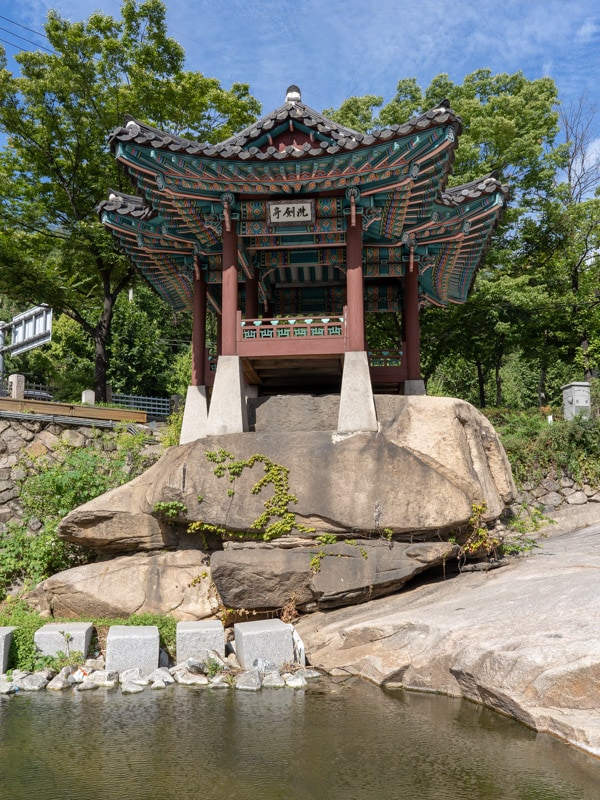
Segeomjeong Pavilion is a pavilion located on Hongjecheon Stream at the base of Mount Bugaksan in northwest Seoul. Due to its location, surrounded by nature, and built on a stream, the pavilion has been mentioned in many literary works, poems, and essays over the years.
While historians aren’t exactly sure when the pavilion was first built, its history dates back hundreds of years. For centuries, ordinary citizens, visiting Chinese officials, and warriors have stopped here to refresh, prepare for battle, or enjoy the surrounding views. It was considered one of the best places to refresh on a hot summer day.
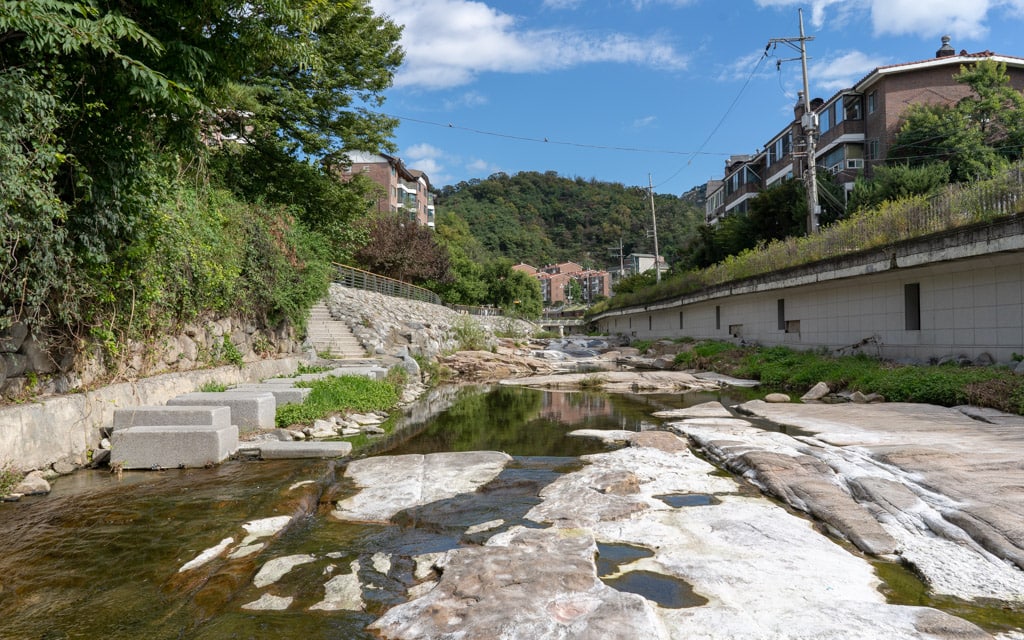
Hongjecheon Stream, which runs for 13.92 kilometers (8.64 miles), is a tributary of the Hangang River. Hongjecheon flows through Jongno-gu, Seodaemun-gu, and Mapo-gu.
The stream was previously known as Hongjewoncheon due to its location near the Joseon-era Hongjewon rest area. Today, the stream is popular for its waterfall and bicycle path.
Many believe that during the Injo Coup of 1623, leaders of the coup passed through Changuimun Gate before stopping in front of the pavilion to wash their swords in the stream as they prepared for their attack on the palace.
Their mission was to dethrone King Gwanghae, the fifteenth king of the Joseon dynasty. After the coup, people began to call the pavilion Segeomjeong, literally meaning “The Sword Washing Pavilion.”
In 1746, King Yeongjo ordered the relocation of Chongyungcheong, one of five military bases, to the north of Seoul near Hongjecheon Stream. At this time, Yeongjo also decided to completely rebuild the pavilion as a place of rest and leisure.
After a year of construction, the pavilion was completed. From this point on, the pavilion was officially known as Segeomjeong.
Segeomjeong was well maintained from the 18th century into the early 20th century. By the 1930s, during Japan’s occupation of Korea, the area, including the pavilion, had fallen into despair.
In the 1940s, an oil paper factory worker started a fire by throwing a cloth soaked in oil into a nearby garbage bin. The resulting fire spread throughout the neighborhood, eventually destroying the entire pavilion.
All traces of the pavilion were forgotten for the next 30 years, other than the two original stone fountains.

In 1977, the government of Seoul decided to reconstruct the pavilion. Without any building plans, the government relied on an 18th-century painting by Gyeomjae Jeong Seon (1676–1759) as a reference for rebuilding. The painting depicted Segeomjeong with a low wall erected behind it, a gate near a road, and a smaller gate near the stream.
After the reconstruction of Segeomjeong, photographs of the pavilion from the early 20th century were discovered. At this point, authorities realized that the reconstruction differed from the original pavilion.
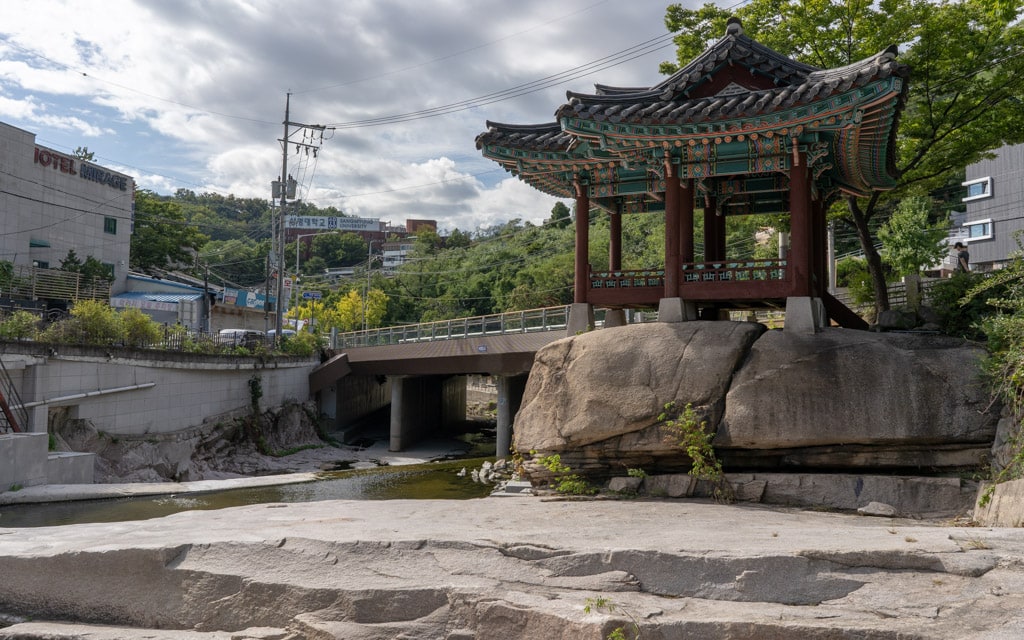
Just below the pavilion is a large, flat rock. This rock is known as canopy rock or chailam (차일암). A state ceremony known as the “Festival of Draft Erasing” or sechoyeon (세초연) took place on this rock.
During this ceremony, paper drafts used during the creation of the Chronicles of the Feudal Joseon Dynasty were placed into the stream, erasing any writings. The paper was then sent to the Royal Paper Mill across the river for recycling.
After the ceremony, the king would host a feast at the pavilion.

Today, residences, buildings, and roads surround the small pavilion. While much of the original atmosphere has disappeared with modernization, visitors who walk down to the stream and the pavilion might forget for just a moment that they are in a metropolis as big as Seoul.
Segeomjeong Pavilion Information
Hours
24 hoursAdmission
Free
Address
244 Segeomjeong-ro, Jongno-gu, Seoul, South Korea
GPS Coordinates: 37.60087, 126.95976
How to Get Here
From Gwanghwamun Square, take bus 1020 to the stop for Segeomjeong, Sangmyung Univ. Continue for 100 meters to reach the pavilion on the right.Map
Additional Resources
Viator by TripAdvisor
Viator is a popular online platform that helps travelers book tours, activities, and unique experiences worldwide, including in Seoul. It connects users with a wide selection of options – from sightseeing tours to cultural events and outdoor adventures – all offered by local providers.
Klook
Klook offers discounted tickets and reservations for various attractions and services in Seoul, from theme parks and museums to tours and transportation options.
Rakuten
Save money while exploring Seoul with Rakuten's cashback program. Book your hotels or other services through Rakuten and enjoy cashback rewards and exclusive deals.
If you sign up using the link below, you could earn $30 cashback on your first purchase over $30.
Book Recommendations
For an immersive guide to Seoul, many travelers choose to bring a book along. Fodor's Seoul, for example, offers detailed recommendations on sights, restaurants, maps, and travel tips.
Nearby Sights
Hongjimun Gate and Tangchundaeseong Fortress

Hongjimun Gate is the main gate of Tangchundaeseong Fortress, built in 1719 during King Sukjong's reign. It served as a key defensive structure linking the Seoul City Wall (Hanyangdoseong) with Bukhansanseong, strengthening the capital's fortifications. Situated on the northern side of Hanseong, the name of Seoul during the Joseon Dynasty, Hongjimun was also called Hanbukmun.
Read more about Hongjimun Gate and Tangchundaeseong Fortress
Changuimun Gate (Jahamun Gate)
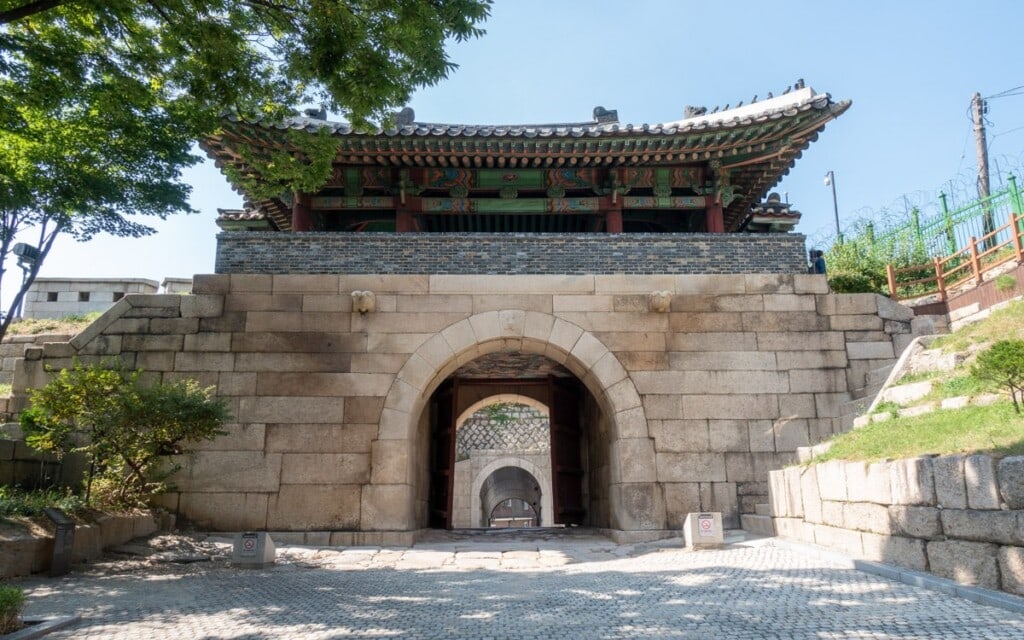
Changuimun Gate, located in northern Seoul, is one of the Four Small Gates of Seoul Fortress. In the past, the gate has also been known as Jahamun and Buksosomun. Construction started in 1396 during the beginning years of the Joseon Dynasty. Built north of the city, Changuimun became a major link between the city and areas to the north.
Yun Dong-ju Literature Museum
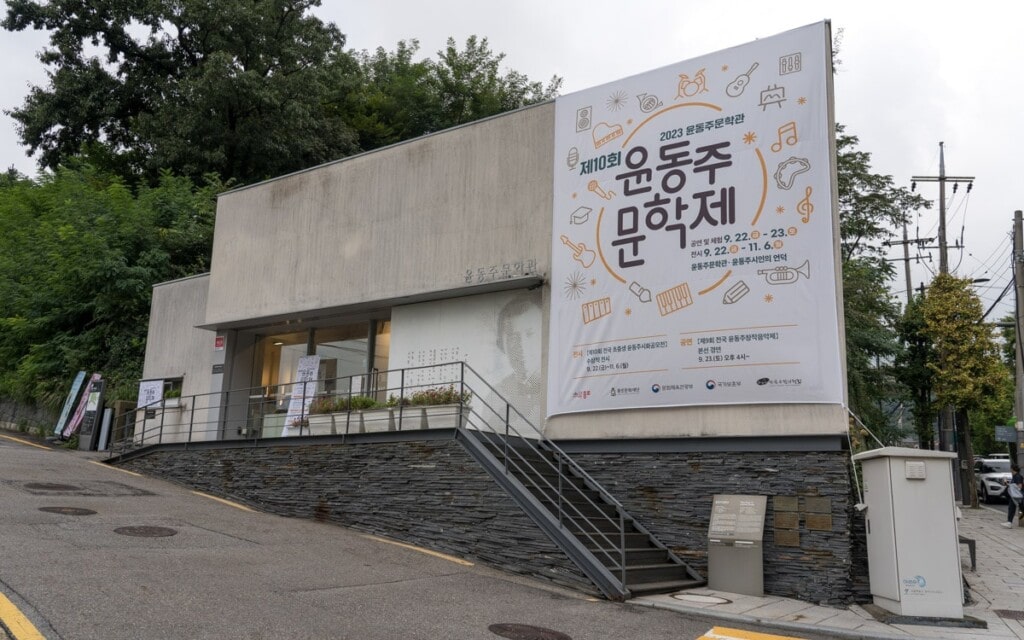
The Yun Dong-ju Literature Museum is dedicated to Yoon Dong-ju, one of Korea's most beloved poets. Yoon's extensive collection of over 100 poems, including 'Sky, Wind, Stars, and Poem,' was profoundly influenced and shaped by the colonial rule that prevailed during his lifetime. Yoon composed his entire body of poetry in the Korean language.
Cheongun Literature Library

Cheongun Literature Library, the first hanok public library in Seoul, sits surrounded by nature at the foot of Inwangsan Mountain. Built by the Jongno-gu Office, it blends traditional architecture with the surrounding landscape. A hanok is a traditional Korean house built with natural materials like wood, clay, stone, and traditional Korean paper (hanji).
Sukjeongmun Gate

Sukjeongmun Gate is the most northern of the Four Main Gates of Seoul Fortress. It is also known as Bukdaemun, literally meaning North Big Gate. When originally built in 1396, it was known as Sukcheongmun. In the 16th century, it was renamed to Sukjeongmun, which means Rule Solemnly Gate. Sukjeongmun was built north of Seoul behind Gyeongbokgung Palace.
Last Updated on Feb 7, 2025

